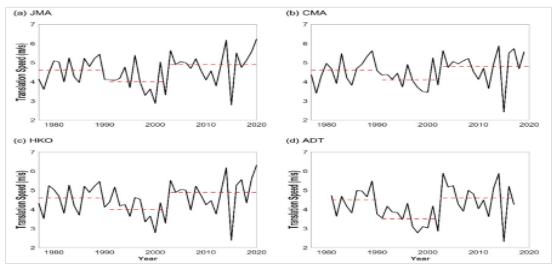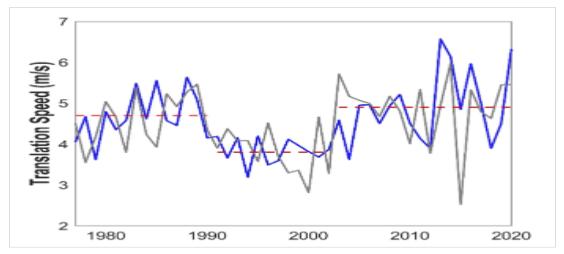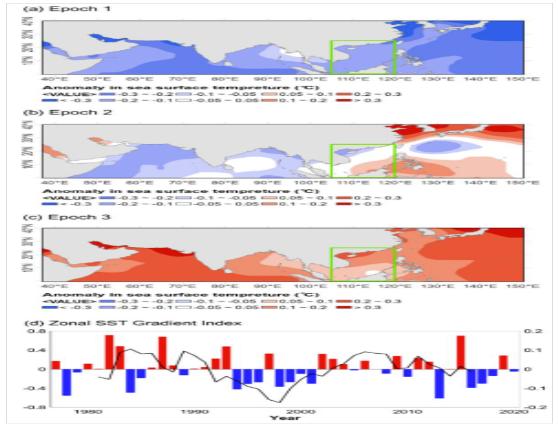Shan, K., Chu, P.-S. & Yu, X. (2023). Interdecadal Change of Tropical Cyclone Translation Speed during Peak Season in South China Sea: Observed Evidence, Model Results, and Possible Mechanism. Journal of Climate.
https://doi.org/10.1175/JCLI-D-22-0704.1
Dr. SHAN Kaiyue from the research team on coastal ocean dynamics at Tsinghua University published a paper in an authoritative climate journal “Journal of Climate,” revealing the patterns of variation in the movement speed of cyclones in the South China Sea and their underlying physical mechanisms. This study, with Dr. SHAN Kaiyue as the first author and Dr. YU Xiping as the corresponding author, was originally conducted when Dr. YU Xiping served as a professor in the Department of Hydraulic Engineering at Tsinghua University. Dr. YU later transferred to become a chair professor in the Department of Marine Science and Engineering at Southern University of Science and Technology. Other collaborators on the paper include Professor CHU Pao-Shin from the University of Hawaii in the United States.
1.Research Background
The South China Sea region in China is one of the world’s typical semi-enclosed sea areas. It is actively involved in important economic activities such as offshore wind power development and underwater mining. Additionally, the surrounding continental areas have a dense population, making them vulnerable to the impacts of natural disasters. Cyclones are the most destructive natural disasters in the South China Sea region, causing enormous damage to the surrounding areas. Therefore, a comprehensive understanding of the patterns and variations in cyclone activities in the South China Sea is significant. It plays a crucial role in ensuring the orderly conduct of economic activities in the region and supports the development of disaster prevention and reduction decisions for the surrounding countries and regions.
2. Research Content
This study focuses on the characteristics of cyclone movement speed in the South China Sea region. Cyclones that move at a slower speed often cause more severe impacts. The slower the cyclone’s movement speed, the longer its duration of impact on economic activities in the affected maritime areas and the lives and properties of coastal populations. Consequently, the proportional increase in the duration enhances the impact of associated disasters, such as strong winds, heavy rainfall, storm surges, and massive waves accompanying the cyclone.
Based on the comparative results of multiple global major datasets, this study reveals significant decadal variations in cyclone movement speed in the South China Sea region over the past seven decades (see Figure 1). Specifically, the cyclone movement speed exhibited a noticeable decrease, approximately 20% below the average level, from the early 1990s to the early 21st century. This implies that, for cyclones of the same intensity and size, their slower movement speed during this period resulted in more severe disaster impacts. In fact, there were abnormally high casualties and economic losses caused by cyclone disasters during this time frame.

Figure 1. Time series of cyclone movement speed in the South China Sea based on multiple major global datasets.
To explore the underlying physical mechanisms, this study conducted model simulations and analyzed reanalysis data. Using a previously independently developed cyclone track model, the study simulated cyclone movement speed in the South China Sea region. The findings revealed that this model could effectively reproduce the decadal variations in cyclone movement speed in the South China Sea (see Figure 2). Sensitivity analysis of the model experiment results indicates that the variation in cyclone movement speed in the South China Sea is significantly influenced by steering winds. The southeastward steering winds in the northern South China Sea and southwestward steering winds in the southern part weakened from the early 1990s to the early 21st century, while they were relatively stronger in the preceding and subsequent periods.

Figure 2. Simulation of decadal variations in cyclone movement speed in the South China Sea based on the independently established cyclone track model, consistent with observed data.
The decadal variations in steering winds in the South China Sea are primarily attributed to the east-west oscillation of the Western Pacific Subtropical High. When the Western Pacific Subtropical High weakens, retreats eastward, and moves away from the South China Sea, the pressure gradient on the southwest side of the subtropical high is smaller, inducing weaker steering winds. Conversely, the opposite is true. This change is likely driven by the meridional sea surface temperature gradient between the North Pacific and the Northwest Pacific regions. This study introduces a new index, the sea surface temperature meridional gradient index, defined as the meridional sea surface temperature gradient between the North Pacific and the Northwest Pacific regions (see Figure 3). The results indicate that this new index can effectively characterize the decadal variations in cyclone movement speed in the South China Sea region. It holds significant implications for the future prediction and estimation of cyclone movement speed in the South China Sea, as well as the reconstruction of historical data on a long-time scale.

Figure 3. Introducing the North Indian Ocean-Western Pacific Sea Surface Temperature Meridional Gradient Index.
3. Research Outlook
In the future, the research team on coastal ocean dynamics at Tsinghua University will continue to focus on understanding how various key features of cyclones in the South China Sea respond to climate change. The team aims to establish a systematic understanding of the physical patterns of cyclones in the South China Sea and develop corresponding measures. This effort is intended to provide technological support for actively addressing climate change and expanding the space for the development of the marine economy during the 14th Five-Year Plan period in China.